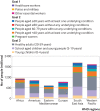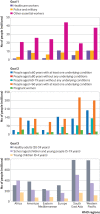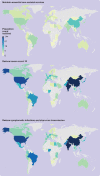Global, regional, and national estimates of target population sizes for covid-19 vaccination: descriptive study
- PMID: 33323388
- PMCID: PMC7736995
- DOI: 10.1136/bmj.m4704
Global, regional, and national estimates of target population sizes for covid-19 vaccination: descriptive study
Abstract
Objective: To provide global, regional, and national estimates of target population sizes for coronavirus disease 2019 (covid-19) vaccination to inform country specific immunisation strategies on a global scale.
Design: Descriptive study.
Setting: 194 member states of the World Health Organization.
Population: Target populations for covid-19 vaccination based on country specific characteristics and vaccine objectives (maintaining essential core societal services; reducing severe covid-19; reducing symptomatic infections and stopping virus transmission).
Main outcome measure: Size of target populations for covid-19 vaccination. Estimates use country specific data on population sizes stratified by occupation, age, risk factors for covid-19 severity, vaccine acceptance, and global vaccine production. These data were derived from a multipronged search of official websites, media sources, and academic journal articles.
Results: Target population sizes for covid-19 vaccination vary markedly by vaccination goal and geographical region. Differences in demographic structure, presence of underlying conditions, and number of essential workers lead to highly variable estimates of target populations at regional and country levels. In particular, Europe has the highest share of essential workers (63.0 million, 8.9%) and people with underlying conditions (265.9 million, 37.4%); these two categories are essential in maintaining societal functions and reducing severe covid-19, respectively. In contrast, South East Asia has the highest share of healthy adults (777.5 million, 58.9%), a key target for reducing community transmission. Vaccine hesitancy will probably impact future covid-19 vaccination programmes; based on a literature review, 68.4% (95% confidence interval 64.2% to 72.6%) of the global population is willing to receive covid-19 vaccination. Therefore, the adult population willing to be vaccinated is estimated at 3.7 billion (95% confidence interval 3.2 to 4.1 billion).
Conclusions: The distribution of target groups at country and regional levels highlights the importance of designing an equitable and efficient plan for vaccine prioritisation and allocation. Each country should evaluate different strategies and allocation schemes based on local epidemiology, underlying population health, projections of available vaccine doses, and preference for vaccination strategies that favour direct or indirect benefits.
© Author(s) (or their employer(s)) 2019. Re-use permitted under CC BY-NC. No commercial re-use. See rights and permissions. Published by BMJ.
Conflict of interest statement
Competing interests: All authors have completed the ICMJE uniform disclosure form at www.icmje.org/coi_disclosure.pdf and declare: support from the National Science Fund for Distinguished Young Scholars, Key Emergency Project of Shanghai Science and Technology Committee, and National Science and Technology Major Project of China for the submitted work; MA has received research funding from Seqirus and HY has received research funding from Sanofi Pasteur, GlaxoSmithKline, Yichang HEC Changjiang Pharmaceutical Company, and Shanghai Roche Pharmaceutical Company. None of those research funding is related to covid-19. All other authors report no competing interests.
Figures






Update of
-
Global, regional, and national estimates of target population sizes for COVID-19 vaccination.medRxiv [Preprint]. 2020 Sep 30:2020.09.29.20200469. doi: 10.1101/2020.09.29.20200469. medRxiv. 2020. Update in: BMJ. 2020 Dec 15;371:m4704. doi: 10.1136/bmj.m4704. PMID: 33024985 Free PMC article. Updated. Preprint.
Comment in
-
Global and national estimates of the number of healthcare workers at high risk of SARS-CoV-2 infection.J Hosp Infect. 2021 May;111:205-207. doi: 10.1016/j.jhin.2021.02.012. Epub 2021 Feb 20. J Hosp Infect. 2021. PMID: 33617936 Free PMC article. No abstract available.
References
-
- World Health Organization. DRAFT landscape of COVID-19 candidate vaccines—12 November 2020.
-
- World Health Organization. Coronavirus disease 2019 (COVID-19) situation report – 209 2020 https://www.who.int/docs/default-source/coronaviruse/situation-reports/2....
Publication types
MeSH terms
Substances
LinkOut - more resources
Full Text Sources
Medical
